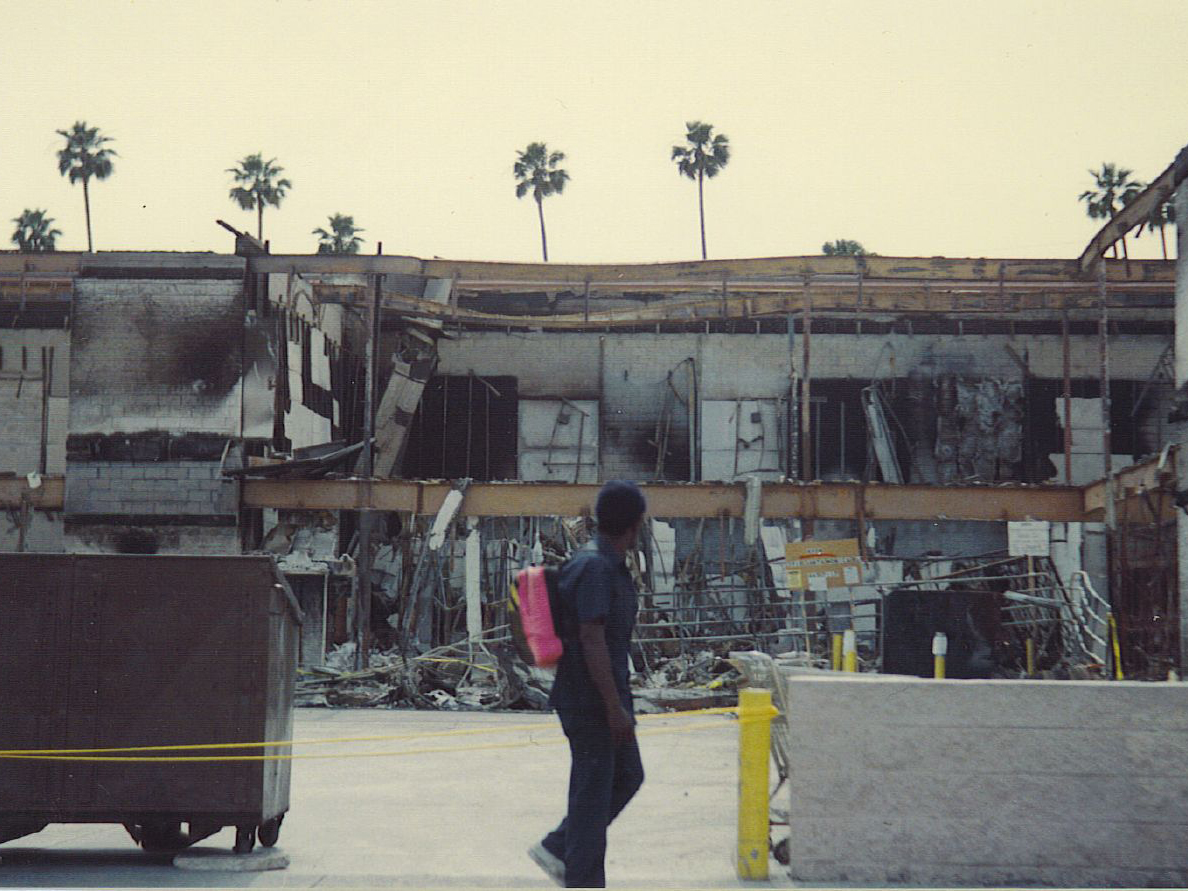
Sunrise to sunset, from Hawthorne to Boyle Heights, Los Angeles houses a mosaic of culturally ethnic residents whose hopes and dreams are centered on the revered city skyline. The burning sun beams scorching the backs of the community’s hustlers and humble hard-workers bears no comparison to the late-afternoon city set ablaze.
In “April 29th, 1992” (1996) the subversive guitarist on lead vocals, Bradley Nowell, provokes, “There was a riot on the streets tell me, where were you?” The fifth track’s title off of Sublime’s self-titled album references the infamous date the LA Riots began. Without missing a beat, he answers his own question: “You were sitting home watching your TV / while I was participatin’ in some anarchy.”
Frontman of the coastal band, who would have been 24 years of age during the Los Angeles Riots of 1992, describes a presumably fictitious string of illegal activities he and his bandmates got away with amid protests against one of many trial cases involving the Los Angeles Police Department.
Nowell inserts himself into the riots through the lyrics of “April 29th, 1992.” He and the three other credited writers detail a pack of young, white men loading up on “alcohol they can’t afford” as protestors destroy the local liquor store and smash through the window of a music shop to take music equipment.
As they load home furnishing into their van, the narrator describes what he sees around him. “Some kids went in a store with their mother / I saw her when she came out she was getting some Pampers,” a testament to economically poor families’ lack of access to items necessary to live.
Courtroom journalists and invested community members alike observed as conclusions on charges of excessive force were returned. In the spring of 1992, four officers caught on a recorded video beating LA resident Rodney King with a baton for 15 minutes during a standard arrest were each acquitted of all charges, but corruption has long become closely linked with the LAPD. Visual reminders that violent actions occur are just that: reminders of an undisturbed, unfortunate and avoidable trend of lives lost.
After government agents planted crack-cocaine into neighborhoods predominantly populated by Black people to fund the 1980s War on Drugs, LAPD would be granted free reign to target Black and Chicano addicts over minor possession charges. South Central Los Angeles was a war zone by the early 90s.
In the six days that followed the “non-guilty” verdict, residents in the city of Los Angeles responded with civil unrest. Protestors with “No justice, No peace” signs cultivated a presence along 75th Street before riots erupted on the intersection of Florence and Normandie. From starting structure fires to throwing bottles into oncoming traffic, public displays of resistance yielded bloodshed under the evening moonlight.
Steady, hard-hitting percussion underlay Nowell’s candid vocals: “Everybody in the hood has had it up to here / it’s getting hotter and hotter and harder each and every year.” The track’s messaging is explicitly anti-establishment; they co-opt themselves as part of the “hood,” but they stand politically not with a deep attachment to the protest’s cause in support of the communities they draw inspiration from, but an angsty call to anarchy for its own sake.
In the midst of public expressions of grief and calls to change, heightened violent interactions between business owners defending their property from looters is what propelled the 1992 riots to persist for just short of a week. LA’s beloved array of local merchants became equipped with firearms on an open playing-field against those marjoly without affiliation to the racially-centered socio-political advocacy.
That demographic would be Sublime’s exact target audience. The Long Beach-based band pulled from elements of the Black musical tradition and borrowed vernacular associated with the same Latin communities who informed their lyrics about selling “oranges by the freeway,” cultivating a dedicated fan base across Southern California’s beach cities.
Their shock value, overt Jamaican influences and energetic guitar riffs reached San Diego, Santa Barbara, Long Beach County and beyond, striking a special chord with the sunshine state skater and the beaded-necklace, cargo shorts-wearing stoner demographic.
“April 29, 1992” was an interesting addition to the 1996 self-titled “Sublime” album. Cuts like “Pawn Shop” allude to Nowell repeatedly exchanging band equipment to go on the drug-induced outings he describes on “Garden Grove.” He screams “Let it burn, wanna let it burn. Let it burn, won’t you let it burn” on the track’s outro, inciting riots in cities across the country.
Despite breaking out in stereotypical, exaggerated Jamaican and Mexican accents in the middle of headbang inducing verses, Sublime went on to crank out hits through LA radio station KROQ. Bradley Nowell would suffer from a fatal heroin overdose related to a recent relapse before the final Sublime album would be released to commercial acclaim. Their blend of ska and reggae, with elements of dancehall and dub infused throughout the record, the album’s lead single “What I Got” would propel “Sublime” to No. 13 on the Billboard 200 chart.
Thirty years removed from the six nights of destruction, the riots have prevailed as a cause worth examining as a way to preserve history. The events that occurred on and after “April 29, 1992” have been no stranger to discourse and media coverage demanding that close attention be paid to systemic injustice. It is important to reflect on what has and what has not yet changed in the years since the LA Riots.







